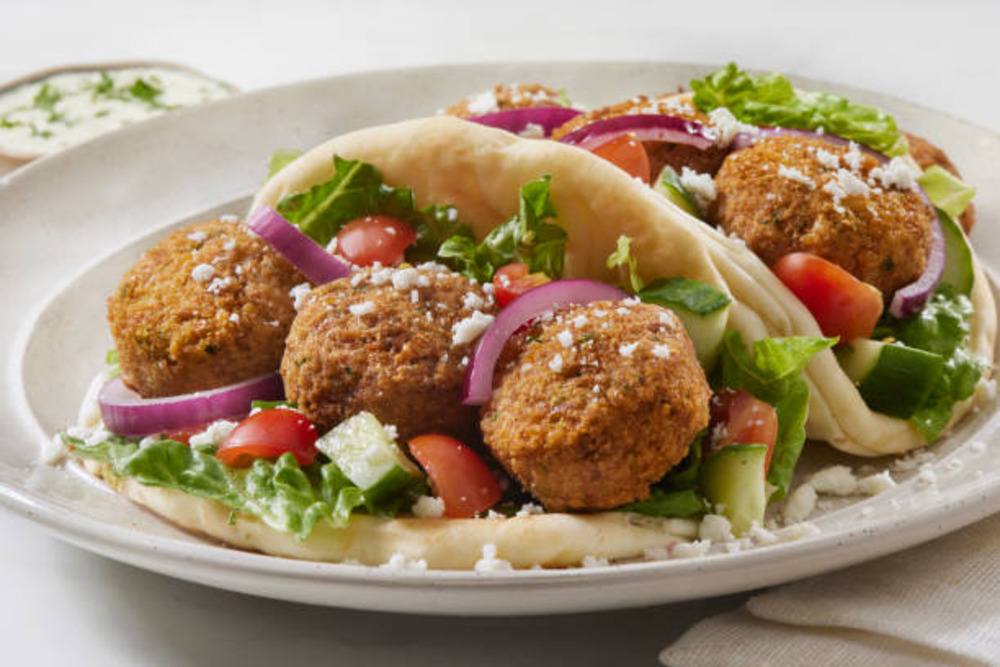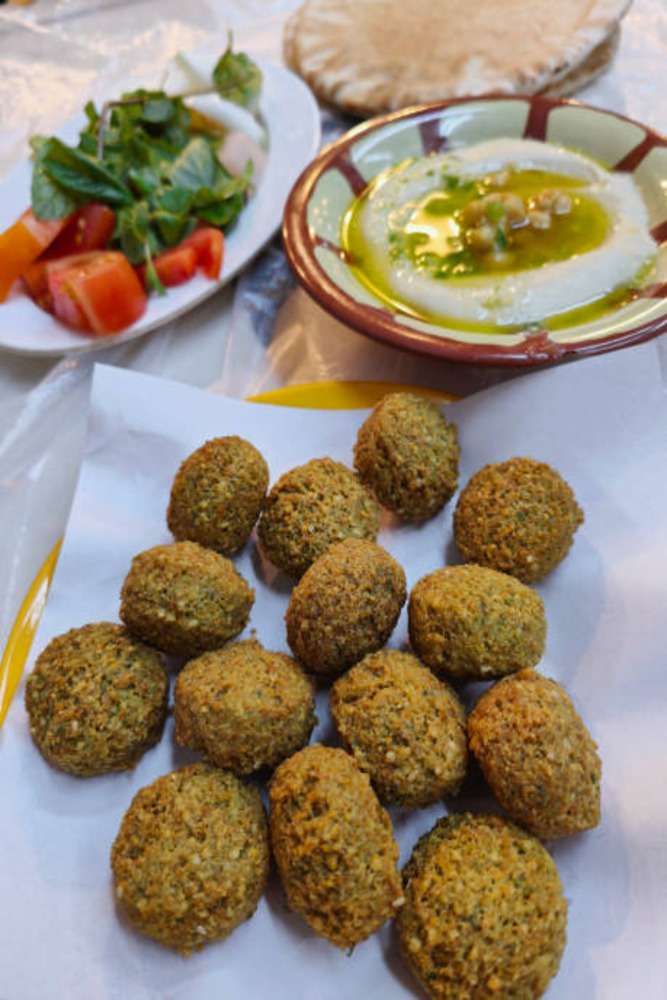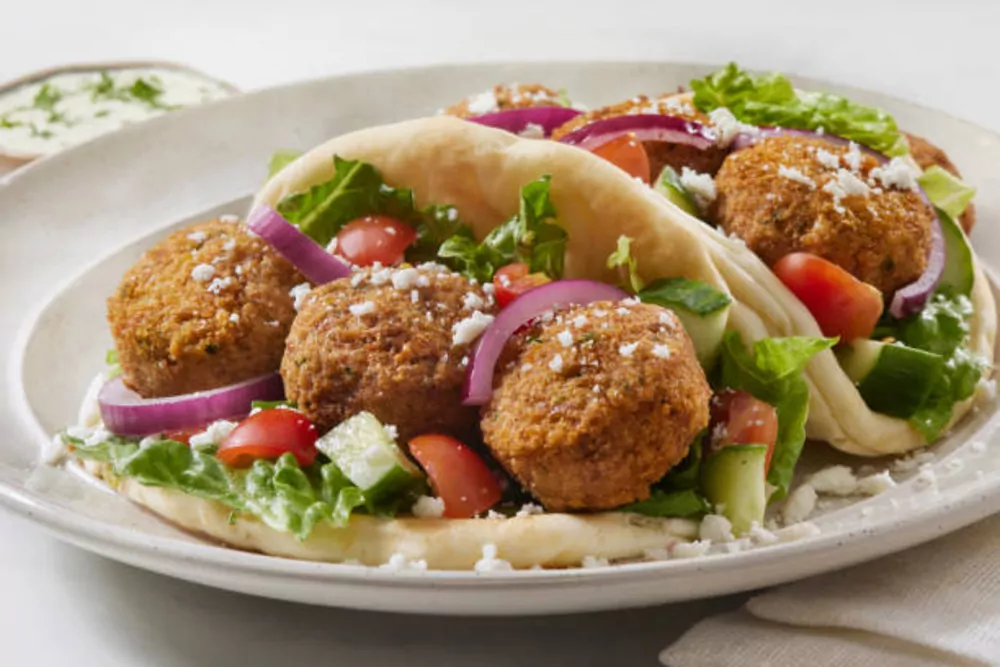Falafel, a beloved Middle Eastern delight, is a vegetarian dish cherished globally for its rich flavors and crispy texture. Traditionally made from ground chickpeas or fava beans, these savory balls or patties are infused with a blend of herbs and spices, offering a unique taste that captivates the palate. The beauty of homemade falafel lies in its freshness and the ability to tailor the flavors to your liking. Crafting your own falafel at home not only ensures a healthier version free from preservatives but also brings the joy of creating a restaurant-quality dish in your own kitchen.

Ingredients
For the falafel, you will need 225 grams (8 ounces) of dried chickpeas, 1 cup of roughly chopped parsley leaves, and 1 cup of roughly chopped cilantro leaves. You’ll also need the white and light green parts of 6 finely chopped scallions or shallots, along with 2 minced garlic cloves. The spice mix includes 1 teaspoon of cumin and 1/2 teaspoon of ground coriander. To ensure proper seasoning, add 1 1/2 teaspoons of salt. For leavening, include 1/2 teaspoon of baking powder. To bind the mixture, use 4 teaspoons of flour (plain/all-purpose or chickpea flour) and 5 tablespoons of water. For frying, have 500 milliliters (2 cups+) of vegetable oil on hand.
The tahini sauce requires 4 tablespoons of tahini, 2 tablespoons of lemon juice, 4 tablespoons of water, and 1/4 teaspoon of salt to taste.
Step-by-Step Instructions
Start by soaking the chickpeas in a large bowl filled with plenty of cold water. This process should take at least 12 hours, but soaking them for up to 2 days will yield the best results. After the soaking period, drain the chickpeas thoroughly.
Next, transfer the drained chickpeas to a food processor. Add the parsley, cilantro, scallions, garlic, cumin, coriander, salt, baking powder, flour, and water. Process the mixture on high for 2 to 3 minutes, scraping down the sides as needed, until the chickpeas are finely ground and the mixture resembles smooth guacamole.
Using a heaping tablespoon of the mixture, shape it into balls, domes, discs, or torpedoes, and place them on a tray. This recipe should yield approximately 20 falafels, each about 2.5 cm (1 inch) wide. Refrigerate the shaped falafels for 30 minutes to firm up.
To fry the falafel, heat the vegetable oil in a skillet or large pot to a depth of at least 1.7 cm (2/3 inch). Heat the oil over medium-high heat until it reaches 180-190°C (355°F). Carefully slide a falafel ball into the hot oil using a large spoon or tongs. Fry in batches for about 4 minutes, turning with two forks to ensure even cooking, until the falafels are deep golden brown and super crusty on the outside. Drain the cooked falafels on paper towels and repeat with the remaining mixture.
Serve the hot falafels with your choice of sauce. They are perfect for making wraps or plates with tabbouleh, tomato, onion, and other sauces.
Recipe Tips
- Ensuring the Perfect Texture: To achieve the ideal texture, make sure to soak the chickpeas for at least 12 hours. This helps soften them, ensuring a smooth blend. Additionally, avoid over-processing the mixture to prevent it from becoming too pasty.
- Tips for Frying Without Falling Apart: Chilling the shaped falafels before frying is crucial. It helps them hold together during cooking. Also, ensure the oil is hot enough before adding the falafels; a small piece of the mixture should sizzle energetically when dropped in.
- Storing and Reheating Leftovers: Store leftover falafels in an airtight container in the refrigerator for up to 3 days. To reheat, bake them in a preheated oven at 180°C (350°F) for about 10 minutes until they are warmed through and crispy.
What to Serve with This Recipe
- Perfect Pairings: Falafel pairs wonderfully with a fresh tabbouleh salad, a mix of finely chopped parsley, tomatoes, onions, and bulgur, dressed in lemon juice and olive oil. The crisp and tangy flavors complement the rich, savory taste of falafel.
- Ideal Sauces and Dips: Besides tahini sauce, consider serving falafel with hummus, a creamy blend of chickpeas, tahini, lemon juice, and garlic, or a zesty yogurt sauce made with Greek yogurt, cucumber, garlic, and mint.
- Creating a Complete Meal: For a full meal, wrap the falafels in pita bread with lettuce, tomatoes, cucumbers, and onions, and drizzle with your favorite sauce. Alternatively, serve them on a plate with a side of roasted vegetables and a drizzle of tahini sauce.
Tahini Sauce Preparation
To prepare the tahini sauce, you’ll need 4 tablespoons of tahini, 2 tablespoons of lemon juice, 4 tablespoons of water, and 1/4 teaspoon of salt. Begin by combining the tahini and lemon juice in a bowl. Mix well until the mixture thickens. Gradually stir in the water, one tablespoon at a time, until the sauce reaches a thick, drizzling consistency. Season with salt to taste, adjusting as needed to suit your preference.
Frequently Asked Questions
- Can I Use Canned Chickpeas? While dried chickpeas are preferred for their texture, you can use canned chickpeas in a pinch. Just be sure to drain and rinse them thoroughly before processing.
- How Can I Make Falafel Without Frying? For a healthier alternative, you can bake the falafels. Preheat your oven to 200°C (400°F), place the falafel balls on a baking sheet lined with parchment paper, and bake for 20-25 minutes, turning halfway through, until golden and crispy.
- What Can I Use Instead of Cilantro? If you’re not a fan of cilantro, you can substitute it with more parsley or use fresh mint for a different flavor profile.
In conclusion, homemade falafel offers a delightful culinary experience, combining vibrant flavors and textures that are far superior to store-bought versions. Whether served in wraps, plates, or alongside an array of sauces and salads, these crispy, golden morsels are sure to impress. Don’t be afraid to experiment with different herbs and spices to make this recipe your own. Enjoy the process and the delicious results!

Ingredients
FALAFELS:
- 225 g / 8 oz dried chickpeas (Note 1)
- 1 cup parsley leaves, roughly chopped
- 1 cup cilantro (coriander) leaves, roughly chopped
- 6 scallions/shallots, white and light green parts only, finely chopped (Note 2)
- 2 cloves garlic, minced
- 1 tsp cumin
- 1/2 tsp coriander
- 1 1/2 tsp salt
- 1/2 tsp baking powder (Note 3)
- 4 tsp flour (plain/all-purpose) or chickpea flour
- 5 tbsp water
FOR FRYING:
- 500 ml / 2 cups+ vegetable oil (Note 4)
TAHINI SAUCE:
- 4 tbsp tahini
- 2 tbsp lemon juice
- 4 tbsp water
- 1/4 tsp salt (adjust to taste)
Instructions
FALAFEL: Soak the chickpeas in a large bowl filled with plenty of cold water for at least 12 hours, or up to 2 days.
After soaking, drain the chickpeas thoroughly. Transfer them to a food processor and add the rest of the falafel ingredients.
Process for 2 to 3 minutes on high, scraping down the sides as needed, until the mixture resembles small grains and has a texture similar to smooth guacamole (refer to the video for guidance).
Using a heaping tablespoon of the mixture, form balls (or domes, discs, or torpedoes) and place them on a tray. You should get approximately 20 falafels, each about 2.5 cm / 1″ wide.
Refrigerate the shaped falafels for 30 minutes.
Heat the oil in a skillet or large pot to a depth of at least 1.7 cm / 2/3″ (Note 4). Heat the oil over medium-high heat until it reaches 180 – 190C / 355F (or until a small bit of the mixture sizzles energetically when dropped in).
Using a large spoon or tongs, carefully slide a falafel ball into the hot oil. Cook in batches for about 4 minutes, turning with two forks to ensure even cooking until the falafels are deep golden brown and super crusty on the outside.
Drain the cooked falafels on paper towels and repeat with the remaining mixture.
Serve the falafels hot with your choice of sauce. They are perfect for making wraps or plates with tabbouleh, tomato, onion, and other sauces. Refer to Notes 5 and 6 for more serving suggestions.
TAHINI SAUCE: In a bowl, combine the tahini and lemon juice, mixing well until the mixture thickens.
Gradually stir in the water, 1 tablespoon at a time, until the sauce reaches a thick, drizzling consistency (refer to the video for the desired texture). Season with salt to taste.

Falafel Recipe
Ingredients
FALAFELS:
- 225 g / 8 oz dried chickpeas Note 1
- 1 cup parsley leaves roughly chopped
- 1 cup cilantro coriander leaves, roughly chopped
- 6 scallions/shallots white and light green parts only, finely chopped (Note 2)
- 2 cloves garlic minced
- 1 tsp cumin
- 1/2 tsp coriander
- 1 1/2 tsp salt
- 1/2 tsp baking powder Note 3
- 4 tsp flour plain/all-purpose or chickpea flour
- 5 tbsp water
FOR FRYING:
- 500 ml / 2 cups+ vegetable oil Note 4
TAHINI SAUCE (OTHER SAUCES NOTE 5):
- 4 tbsp tahini
- 2 tbsp lemon juice
- 4 tbsp water
- 1/4 tsp salt adjust to taste
Instructions
Falafel:
- Soak the chickpeas in a large bowl filled with plenty of cold water for at least 12 hours, or up to 2 days.
- After soaking, drain the chickpeas thoroughly. Transfer them to a food processor and add the rest of the falafel ingredients.
- Process for 2 to 3 minutes on high, scraping down the sides as needed, until the mixture resembles small grains and has a texture similar to smooth guacamole (refer to the video for guidance).
- Using a heaping tablespoon of the mixture, form balls (or domes, discs, or torpedoes) and place them on a tray. You should get approximately 20 falafels, each about 2.5 cm / 1″ wide.
- Refrigerate the shaped falafels for 30 minutes.
- Heat the oil in a skillet or large pot to a depth of at least 1.7 cm / 2/3″ (Note 4). Heat the oil over medium-high heat until it reaches 180 – 190C / 355F (or until a small bit of the mixture sizzles energetically when dropped in).
- Using a large spoon or tongs, carefully slide a falafel ball into the hot oil. Cook in batches for about 4 minutes, turning with two forks to ensure even cooking until the falafels are deep golden brown and super crusty on the outside.
- Drain the cooked falafels on paper towels and repeat with the remaining mixture.
- Serve the falafels hot with your choice of sauce. They are perfect for making wraps or plates with tabbouleh, tomato, onion, and other sauces. Refer to Notes 5 and 6 for more serving suggestions.
Tahini Sauce:
- In a bowl, combine the tahini and lemon juice, mixing well until the mixture thickens.
- Gradually stir in the water, 1 tablespoon at a time, until the sauce reaches a thick, drizzling consistency (refer to the video for the desired texture). Season with salt to taste.
Notes
- Dried chickpeas cannot be substituted with canned ones as it simply won’t work. The weight of dried chickpeas is just shy of 1 1/4 cups.
- Use only the white and light green parts of shallots (green onions/scallions) for an oniony flavor, discarding the dark green parts. Approximately 3/4 cup is needed, but exact measurements aren’t critical.
- Baking powder isn’t used in all falafel recipes, but our taste tests revealed that it makes a significant difference. Falafels with baking powder are fluffier and moister inside, unlike the denser, dough-like texture without it. This tip comes from a renowned falafel shop in Sydney, Hijazi’s Falafel in Earlwood.
- You don’t need to fully deep fry your falafel. Using 2 cups (500 ml) of oil is sufficient if you turn them a few times during cooking. If you shape the falafels into discs, you can use even less oil—possibly just 1 cup (250 ml).
- A sauce is essential with falafel. While traditionally served with tahini sauce, other great options include plain yogurt, yogurt lemon sauce (yogurt, lemon, garlic, salt, olive oil), a thin hummus (thinned with water), or chili/hot sauce. The sauce should be thin enough to add moisture to the dish.
- How to Serve:
- Falafel Wraps/Rolls: Use large or small flatbreads. Smear a dollop of hummus or yogurt (or yogurt lemon sauce) down the middle. Top with tabbouleh or lettuce, tomato, onion, and falafels broken in half. Drizzle with tahini sauce or your choice of sauce (hot sauce is a great addition). Roll or fold and enjoy!
- Falafel Plates: Serve with tabbouleh or shredded iceberg lettuce, tomato slices, and onion (red or white). Add tahini sauce and optional hummus, with pita bread on the side. A spiced pilaf like Mejadra (Middle Eastern Lentil Rice) makes a wonderful addition.
- Tabbouleh Recipe: Soak 2 tbsp bulgur in 3 tbsp boiling water, then fluff. Combine with 2 cups roughly chopped parsley, 1/2 cup roughly chopped mint, 1/2 finely chopped red onion, and 2 large deseeded and chopped red tomatoes. Dress with lemon juice and a sprinkle of salt to taste. For falafel, use minimal salt and plenty of lemon juice.
- Serving Size: 2-3 halved falafels in pita pockets, 3-4 halved for a large roll, or 4-5 for a plate.
- Reheating: Falafel is best served fresh, but for storing and reheating, keep cooked falafel in an airtight container in the fridge for up to 5 days. Reheat in the microwave, then spray with oil and bake at 200°C/390°F for 5 minutes until crispy again.


